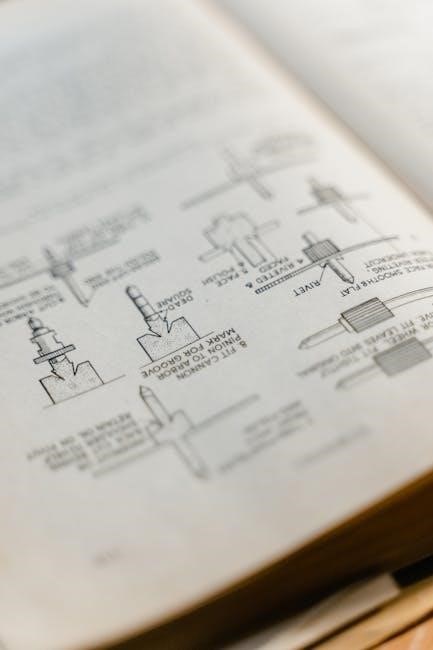Welcome to the microKORG instruction manual! This guide provides a comprehensive overview of the synthesizer’s features, operation, and troubleshooting. Whether you’re a beginner or an experienced musician, this manual will help you unlock the full potential of your microKORG, ensuring optimal performance and creativity.
1.1 Overview of the microKORG Synthesizer
The microKORG is a compact virtual analog synthesizer released in 2002, featuring a retro design and powerful sound capabilities. It combines analog modeling synthesis with a built-in vocoder, offering a wide range of tonal possibilities. With its intuitive interface, 37-key keyboard, and robust effects section, the microKORG is ideal for musicians seeking a portable yet versatile instrument for music production and live performance. Its enduring popularity has solidified its place in modern synthesizer history.
1.2 Importance of Reading the Manual
Reading the microKORG instruction manual is essential to fully understand and utilize the synthesizer’s capabilities. The manual provides detailed explanations of controls, features, and troubleshooting tips, ensuring optimal performance. It serves as a valuable resource for both beginners and experienced users, helping you explore advanced functions and maintain your instrument effectively. By following the manual, you can unlock the microKORG’s potential and enhance your creative workflow.
1.3 Historical Context and Evolution of the microKORG
The microKORG, released in 2002, marked a significant milestone in synthesizer design with its compact, retro-style form factor. Over two decades, it has remained a popular choice among musicians due to its versatility and built-in vocoder. Celebrating its legacy, KORG introduced a translucent special edition in 2022, reflecting its enduring influence in music production and performance. The microKORG’s evolution underscores its adaptability to modern music-making needs.

Getting Started with the microKORG
Welcome to the microKORG! This section guides you through unpacking, initial setup, and powering on your synthesizer. Learn basic controls, connect devices, and start creating sounds.
2.1 Unpacking and Initial Setup
Unpack the microKORG carefully, ensuring all components are included and undamaged. Connect the included microphone for vocoder use and place the synthesizer on a flat, stable surface. Plug in the power adapter, ensuring the VOLUME knob is turned to the left to avoid sudden noise. Power on the device and familiarize yourself with the control panel layout. Adjust settings as needed for optimal performance. Proper setup ensures smooth operation and sound quality.
2.2 Powering On and Basic Controls
Power on the microKORG by plugging in the adapter and turning the VOLUME knob to the right. Ensure the knob is fully left before turning on to avoid sudden noise. Familiarize yourself with the control panel, including the VOLUME knob, VALUE dial, and navigation buttons. Use the cursor buttons to scroll through menus and the category buttons to select parameters. Proper operation of these controls is essential for seamless navigation and sound customization. Explore settings carefully to optimize your experience.
2.3 Connecting the Microphone for Vocoder Use
To use the vocoder, attach the included microphone to the designated holder, following the instructions provided in the manual. Ensure the microphone is securely connected to the microKORG’s input. Proper alignment and positioning of the microphone are crucial for optimal sound capture. Refer to page 5 of the manual for detailed steps on setup and configuration. This will ensure clear audio input for vocoder processing and effects.

Understanding the Control Panel
The microKORG’s control panel features knobs, buttons, and a display for intuitive sound shaping. Knobs adjust parameters, while buttons navigate menus. Symbols indicate cautions, advice, and MIDI explanations.
3.1 Layout and Key Components
The microKORG’s control panel is logically arranged for easy navigation. Key components include the oscillator, filter, and amplifier sections. Knobs are labeled in bold, while parameters are enclosed in quotes. The display shows current settings, and buttons like Shift and Enter aid menu navigation. Symbols denote cautions, tips, and MIDI-related functions, ensuring users understand operational guidelines and optimizations.
3.2 Knobs, Buttons, and Their Functions
The microKORG features a variety of knobs and buttons that control its vast array of functions. Knobs adjust parameters like oscillator pitch, filter cutoff, and resonance, while buttons enable menu navigation and mode selection. The Shift button unlocks secondary functions, and the Enter button confirms selections. MIDI-related controls are clearly labeled, allowing seamless integration with external devices. Proper use of these components ensures intuitive operation and precise sound shaping.
3.3 Navigating the Display and Menus
The microKORG’s display and menu system provide clear access to its features. Use the Value Knob to scroll through menus and adjust parameters. Press Shift to access secondary functions, and Enter to confirm selections. The display shows parameter names and values, while indicators highlight active functions. This intuitive system allows quick navigation, ensuring you can focus on creating music without confusion.

Sound Design and Synthesis Basics
Master the fundamentals of sound design using the microKORG’s synthesis engine. Learn to craft unique sounds by understanding oscillators, filters, envelopes, and LFOs, essential for creating dynamic textures.
4.1 Oscillators and Waveforms
The microKORG features versatile oscillators with four selectable waveforms: sine, square, triangle, and sawtooth. Additionally, a noise generator is available for added texture. These oscillators form the foundation of sound design, allowing you to create a wide range of tonal possibilities. By adjusting waveform types and parameters, you can shape sounds from simple tones to complex, layered textures. The oscillators are clearly labeled on the control panel for intuitive sound crafting.
4.2 Filters and Resonance
The microKORG features a resonant filter section, allowing you to shape your sounds with precision. The filter can be set to low pass, high pass, or band pass modes, each offering unique tonal sculpting possibilities. Resonance adjusts the intensity of the filter’s peak, creating dynamic sweeps or sharp, piercing tones. Proper use of the filter and resonance enables you to craft rich, evolving sounds tailored to your musical needs.
4.3 Envelopes and LFOs
The microKORG offers versatile envelope generators and LFOs (Low Frequency Oscillators) to add dynamic movement to your sounds. Envelopes shape parameters like volume, pitch, and filter cutoff over time, with adjustable attack, decay, sustain, and release settings; LFOs provide rhythmic modulation, with waveforms such as sine, square, and random. These tools allow you to create evolving textures, from subtle tremolos to complex, syncopated effects, enhancing your sound design capabilities.

Using the Vocoder
Explore the creative possibilities of the microKORG’s vocoder, a powerful tool for transforming vocal and audio inputs into unique, synthesized sounds. This section guides you through its operation.
5.1 What is a Vocoder?
A vocoder is an electronic processing tool that captures the characteristics of a vocal input and applies them to another sound source, such as an oscillator. This creates unique, robotic-like voices or complex textures by blending audio signals. The microKORG’s vocoder is user-friendly, allowing musicians to easily experiment with vocal processing and synthesis, making it a powerful feature for creative sound design and performance.
5.2 Setting Up the Vocoder
To set up the vocoder on your microKORG, attach the included microphone to the microphone holder as instructed in the manual. Adjust the input level using the INPUT LEVEL knob to ensure optimal audio signal. Select the Vocoder mode and assign the audio source to process. Fine-tune the parameters to achieve the desired vocal effect, ensuring clear and balanced sound reproduction for creative vocal synthesis.
5.3 Adjusting Vocoder Parameters
Adjust the vocoder parameters by tweaking the Formant and Shift knobs to shape the tone. Use the Level knob to balance the audio input and synthesized sound. Experiment with the Resonance and Bandwidth settings for unique vocal effects. Synchronize the vocoder with the arpeggiator or external MIDI signals for dynamic, layered sounds. Fine-tune these settings to achieve the perfect blend of clarity and creativity in your vocal synthesis.

Effects and Processing
The microKORG offers modulation effects, delay, and an equalizer to enhance your sound. Effects can be synchronized with the arpeggiator or external MIDI for dynamic processing.
6.1 Types of Effects Available
The microKORG features three modulation effects: chorus, phaser, and flanger. Additionally, it includes three delay types and an equalizer. These effects allow for rich sound shaping, with synchronization options for arpeggiator or MIDI sources, enhancing creativity and versatility in your music production.
6.2 Modulation Effects and Delay
The microKORG offers chorus, phaser, and flanger as modulation effects, each providing distinct tonal textures. The delay effect can be synchronized with the arpeggiator or external MIDI sources, allowing for precise rhythmic control. These effects enhance sound design flexibility, enabling users to create dynamic and engaging sounds tailored to their musical style. Experimenting with these features can significantly expand your creative possibilities.
6.3 Equalizer and Additional Processing
The microKORG features a built-in equalizer, allowing precise tone shaping with low, mid, and high controls. Additional processing options include distortion for adding edge and overdrive for warmth. These tools enable users to refine their sounds, ensuring they stand out in any mix. By adjusting these parameters, musicians can achieve the desired sonic character, from subtle tweaks to dramatic transformations, enhancing their creative expression.

MIDI and Connectivity
The microKORG supports MIDI channels for connectivity with external devices. Proper installation ensures optimal performance and prevents radio frequency interference. Synchronize with other MIDI controllers.
7.1 Understanding MIDI Channels
MIDI channels enable communication between the microKORG and external devices. The synthesizer supports multiple MIDI channels, allowing seamless integration with other MIDI-compatible gear. Proper setup ensures optimal performance, while adhering to instructions prevents radio frequency interference. MIDI channels facilitate control over various parameters, enhancing creativity and synchronization. Always refer to the manual for detailed configurations and troubleshooting tips to maximize your MIDI experience with the microKORG.
7.2 Connecting to External Devices
To connect the microKORG to external devices, use MIDI cables for seamless communication. Ensure correct cable connections between MIDI OUT and the external device’s MIDI IN. Power off all devices before connecting to prevent damage. Proper setup ensures synchronization and optimal performance. Always refer to the manual for specific configurations and troubleshooting tips to maximize compatibility and functionality with external MIDI controllers and synthesizers.
7.3 Syncing with Other MIDI Controllers
To sync the microKORG with other MIDI controllers, set both devices to the same MIDI channel. Ensure the microKORG is configured to receive MIDI data via its MIDI IN port. Select the correct MIDI channel on the microKORG and mirror this setting on the external controller. Test the connection by playing the controller and verifying the microKORG responds. Proper synchronization enables seamless integration and control, enhancing your musical workflow and creativity.

Arpeggiator and Step Arpeggiator
The microKORG’s arpeggiator transforms chords into dynamic melodic sequences. It offers six arpeggio types, enabling you to create intricate patterns. The step arpeggiator adds rhythmic complexity, enhancing your sound design and live performances.
8.1 What is an Arpeggiator?
An arpeggiator is a feature that transforms chords into melodic sequences by playing individual notes in a rhythmic pattern. It allows you to create dynamic, intricate sounds effortlessly. On the microKORG, the arpeggiator can generate six different arpeggio types, providing versatility for various musical styles. This tool is perfect for adding movement and depth to your performances and recordings, making it a key component for both beginners and advanced users.
8.2 Using the Step Arpeggiator
To use the Step Arpeggiator on the microKORG, simply hold down a chord on the keyboard. The arpeggiator will automatically play the individual notes in a rhythmic pattern. You can choose from six arpeggio types, each offering unique sequential playback. This feature is perfect for creating dynamic, layered sounds. It also synchronizes with external MIDI devices, allowing seamless integration into your music production or live performances. Experiment with different patterns to enhance your sound design and creativity.
8.3 Synchronizing Arpeggiator with Effects
The microKORG allows you to synchronize the arpeggiator with effects like delay and modulation. This creates a cohesive sound where rhythmic patterns align with processing. Use MIDI sync to lock the arpeggiator to external devices or internal effects. Adjust delay time to match arpeggio speed for seamless integration. This feature enhances your sound design by creating dynamic, synchronized textures that elevate your music production or live performances to new levels.

Maintenance and Troubleshooting
Regularly clean the exterior and knobs to maintain functionality. Check for firmware updates to ensure optimal performance. Troubleshoot common issues like connectivity problems or sound glitches promptly.
9.1 Cleaning and Care Tips
Regularly clean the microKORG’s exterior with a soft, dry cloth to prevent dust buildup. Avoid harsh chemicals or abrasive materials that may damage the finish. Gently wipe knobs and buttons to maintain functionality. Never expose the device to extreme temperatures or moisture. For internal maintenance, refer to authorized service centers. Proper care ensures optimal performance and longevity of your microKORG.
9.2 Common Issues and Solutions
Addressing common issues ensures smooth operation of your microKORG. Power-on problems? Check battery levels or AC adapter connections. MIDI issues? Verify MIDI channels and connections. Audio glitches? Restart the device or update firmware. For persistent problems, consult the manual or contact KORG support. Regular maintenance and updates help prevent issues. Always refer to official resources for reliable solutions.
9.3 Updating Firmware and Software
To ensure optimal performance, regularly update your microKORG’s firmware and software. Visit the official KORG website to download the latest versions. Follow the on-screen instructions carefully to avoid installation errors. Power off external devices before updating. Once complete, restart the microKORG to apply changes. Updates often include new features, bug fixes, and improved functionality. Always use official KORG sources to maintain compatibility and security.

Resources and Further Learning
Explore official KORG resources, online tutorials, and community forums for in-depth learning. Check out THE MICROKORG COOKBOOK and downloadable manuals for comprehensive guides and updates.
10.1 Official microKORG Manuals and Guides
The official microKORG manuals and guides are essential resources for mastering the synthesizer. Available for download from KORG’s website, these documents include detailed instructions, setup tutorials, and troubleshooting tips. The manuals cover everything from basic operations to advanced sound design, ensuring you make the most of your microKORG. Supplementary materials like quick start guides and voice name lists are also provided for convenience.
10.2 Online Tutorials and Videos
Online tutorials and videos provide valuable insights for mastering the microKORG. Platforms like YouTube and forums offer step-by-step guides, covering topics from basic setup to advanced sound design. These resources are ideal for visual learners, offering practical demonstrations of features like the vocoder, arpeggiator, and effects processing. Many tutorials are created by experienced musicians, sharing tips and tricks to help users maximize their creative potential with the microKORG.
10.3 Community Forums and User Groups
Community forums and user groups are excellent resources for microKORG enthusiasts. These platforms allow users to share patches, tips, and tricks, fostering collaboration and learning. Many forums feature discussions on troubleshooting, sound design, and creative techniques. Additionally, communities like The microKORG Cookbook offer custom patches and tutorials, further enhancing your synth experience. Engaging with these groups provides valuable insights and helps you stay connected with other microKORG users worldwide.
Mastering the microKORG opens doors to endless creativity. Embrace exploration, experiment with sounds, and enjoy the journey of musical discovery made possible by this versatile synthesizer.
11.1 Final Tips for Mastering the microKORG
Consistently practice and experiment with new sounds to unlock the microKORG’s full potential. Use the manual and online resources to deepen your understanding. Explore the vocoder and arpeggiator for unique textures. Regularly update firmware and join communities for inspiration. Remember, mastery takes time—enjoy the creative journey and push the boundaries of what this versatile synthesizer can achieve.
11.2 Encouragement to Explore and Create
Embrace the microKORG as a tool for limitless creativity and self-expression. Celebrate its legacy, now spanning over two decades, with new editions like the microKORG S. Dive into its intuitive design, experiment with unique features like the vocoder, and explore endless sound possibilities. Stay inspired by online communities and tutorials, and remember, every patch you create tells a story. Keep experimenting, learning, and most importantly, enjoy the journey of making music!
